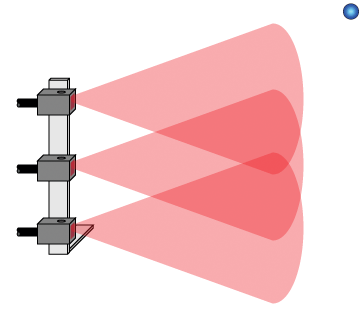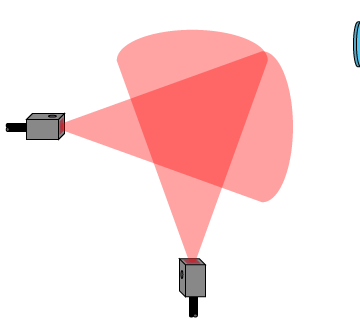100 Discovery Way, Unit 110, Acton, MA 01720 US.
Mon-Fri, 8:00 AM - 5:00 PM (GMT-5)
Using Diffuse Reflective Sensors for Detecting Part Ejection
The diffuse reflective photosensor is one of the most popular sensors for detecting part ejection. They are inexpensive and reliable, and a single sensor can detect parts over a relatively large area. These sensors are small and self-contained (emitter and receiver in the same housing) making them very easy to install.
These devices are quite sensitive enough to detect small, fast moving (even non-reflective) parts quite easily. The downside of this sensitivity is that the diffuse reflective sensor is prone to false actuations caused by background objects. Large objects can be detected in the background even if they are located well beyond the maximum range of the sensor. For example, a white painted wall 6 feet away will actuate a sensor with a 24" range. Care must be taken during installation to ensure that background items will not cause false actuations.

Diffuse Reflective Photosensor Detecting a Part
One of the reasons this sensor is so often used for detecting part ejection is that, for its size, it can detect parts anywhere in a large area. However, because of the seemingly random trajectory of some air-ejected parts, a single sensor's detecting area might not be large enough to reliably detect the part every time.
The solution to this problem is simple: Use more than one sensor.

Diffuse Sensor 'Screen' Detecting Randomly Ejected Parts
You can 'stack' as many diffuse reflective photosensors as necessary to provide coverage of the entire area through which the part can eject, making a diffuse sensor 'screen'. All sensors should be wired in parallel to a single input on your die protection control. This way, the input will activate any time one or more of the sensors detects a part.

Two sensors installed at 90° to each other can detect flat parts regardless of orientation
Even when parts take a repeatable path out of the die, the shape of the part may require you to use more than one sensor. For example, if a part is flat and very thin, the sensor may have difficulty detecting it if it flies through the emitter beam with the narrow edge oriented toward the sensor. If this is the case, a second sensor installed with the beam aimed at 90° to( and wired in parallel with) the first will ensure reliable detection.
One final note: When sensing air-ejected parts, it is important that you only use infrared diffuse reflective sensors to minimize the possibility of sprayed lubricant causing false actuations.
© Copyright 2021 Wintriss Controls Group LLC - All Rights Reserved